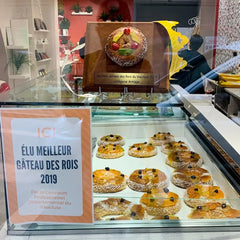
Why the « gâteau des rois » means so much to our family
Since the 14th century, the French have found a delicious way to beat the post-Christmas blues—more food, of course! January is the month of the galette des rois, the king cake.
While there are several variants, all of them draw on delicious ingredients lauded in French baking, be it almonds, candied fruit, or chocolate pear, and they’re usually adorned with a golden paper crown. More on that later!
Traditionally, galette des rois was served on the 12th day of Christmas, January 6th, which heralds the arrival of the Three Wise Men and the start of the Epiphany. These days, you’ll find them in the stores from mid-December, and they’re enjoyed all throughout January.
But the cake isn’t just about flavour. The real excitement comes from seeing if your slice contains la fève, the bean, which was previously a fava bean, but these days is a porcelain or plastic figurine. Find la fève in your slice and you’re declared the king or queen, meaning that crown on top of the cake is yours. The monarchy comes with responsibility though, as you’re in charge of buying the next cake!
In Provence, we do things a little differently. Whereas northern France serves a flat puff pastry cake filled with frangipane, the Provençal gâteau des rois is a brioche ring made with orange blossom and covered in sugar and candied fruits.
These fruits symbolise the precious gifts brought by the Three Kings and so our version is often called the Three Kings cake. They’re made in Apt, the world’s candied fruit capital, in a factory where our own grandfather used to work.
As you’d expect from the generous Provençal people, we don’t skimp on the cake’s hidden gift either! Our gâteau des rois contains a santon, the traditional porcelain nativity figurine, hidden inside it. Read our previous post for more about santons and what they mean to us.
Like all kids in Provence, Pierre and I loved the tradition of the gâteau des rois. We always wanted to be the one to find la feve, take that crown and be king for a day. Add to that excitement my love of santons and you can understand why this was, and remains, such a special part of Provençal culture to me.







